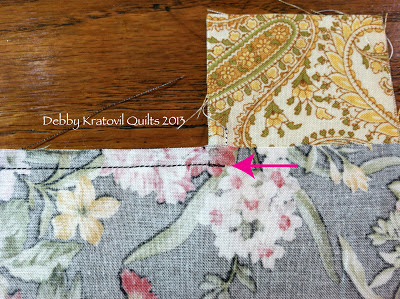My name is Katie Blakesley (Swim, Bike, Quilt) and I love to sew and spend lots of time in the great outdoors. Each year, I host a charity quilt drive (where quilters donate quilts in their own communities) called 100 Quilts for Kids. This year, the online event will be held from July 1- September 30--I would love to have you join me! I am also thrilled to share that my first book Vintage Quilt Revival: 22 Modern Designs from Classic Blocks
I am excited to share this {reversible} Summer Tote tutorial with you today. I made several versions of this simple, versatile tote out of The Big Apple, a new fabric line by Greta Lynn for Kanvas Studios. The Big Apple is my favorite Benartex line--I thought it was fun for adults and kids alike. Who doesn't love New York City? I wanted to make a few tote bags that would be perfect for summer--lightweight, casual, able to hold lots of library books (tested by my 6 year old), and reversible.
Note: All seams are 1/2'' and if you are using directional fabric, please pay attention when cutting. Finished bag measures approximately 14'' (w) x 16'' (h).
Materials:
1 yard feature fabric
1 yard fusible interfacing (I chose a lightweight Pellon)
1/2 yard lining fabric
Cutting Directions:
Feature Fabric:
(2) 15'' x 17.5'' rectangles
(2) 3'' x 26'' strips
(1) 7'' x 10'' rectangle for each optional inside pocket
Fusible Interfacing:
(2) 15'' x 17.5'' rectangles
(2) 2.5'' x 26'' strips
(1) 7'' x 10'' rectangle for each optional inside pocket
Lining Fabric:
(2) 15'' x 16.5'' rectangles
Assembly Directions:
Fuse Interfacing to Fabric
1. Cut all fabric according to measurements above. If you are using a directional fabric (such as the map fabric in this tote) pay attention to fabric direction and placement.
2. Follow the manufacturer's instructions to fuse the (2) 15'' x 17.5'' rectangles to the (2) feature fabric rectangles. Also fuse the 7'' x 10'' interfacing to the 7'' x 10'' feature fabric for each (optional) pocket. Note: This is the perfect size for a smart phone and a set of keys; vary the size and number of pockets if you wish.
Make the Handles
3. Center the (2) 2.5'' x 26'' pieces of interfacing (fusible side down) on the wrong side of the (2) 3'' x 26'' feature fabric strips. Turn them over carefully, and fuse according to the manufacturers directions.
4. Place one 3'' x 26'' strip of feature fabric wrong side up, fold over one edge 1/4'' and press; repeat with the other side.
5. Fold the strip in half (wrong sides together), pin if desired, and first stitch along the "raw" edge of the strip, close to the edge. Stitch along the folded edge of the strip.
Make the (optional) pocket)
7. Fold the 7'' x 10'' fused fabric, right sides together. Stitch a 1/2'' seam along the bottom and one side of the pocket (remember to backstitch on each end). On the remaining side, stitch a 1/2'' seam for about an inch and back space. Leave a 2.5'' opening, and then stitch the rest of the seam closed. Trim the corners as shown.
8. Turn the pocket right side out; use a point turner or a chopstick to press out the corners and make them crisp. Press the pocket open and top stitch along the top (folded side) of the pocket and set aside until step 13.
Assemble the Tote
9. Place the two outer pieces right sides together. Pin if desired, sew a 1/2'' seam along the bottom (backstitch at the ends), and press.
10. Sew a 1/2'' seam on both sides of the tote, backstitching at the top and bottom. Trim the corners as shown in step 7. Press seams as desired (I pressed the seam towards the front of the tote).
11. Turn the tote inside out. Use a chopstick or point turner to press out the corners and make them crisp. Press the outside of the tote.
12. Place the outer shell on your ironing board, and carefully fold the top of the tote towards you 1/2''; press. Then, fold it an additional 1'' and press.
13. Center the pocket on one of the lining pieces (about 3'' from the top). Stitch around the 3 edges of pocket; I usually stitch a little triangle at the top of both sides of the pocket to reinforce the pocket.
15. Sew a 1/2'' seam on both sides of the tote, backstitching at the top and bottom. Press seams as desired (I pressed the seams towards the back of the tote). Do not turn the lining right side out.
16. This is the part where you need some finesse. Place the lining inside the (right side out) outer shell. Slide the lining under the "hem" you pressed in step 12. You may have to do some wiggling until the lining fits smoothly under the hem.
Attach the Handles
18. You are almost done! Pin the handles as shown, 3.5'' from either side of the side seam and 1.25'' from the top. Note: Be sure not to twist the handles when pinning them.
19. Use a zig zag stitch, and start at the bottom (raw edge) of the handle. Stitch right along the raw edge, and then stitch in a square. I also added an X through the middle of the square. Repeat with the other side of the handle.
Enjoy the tote as is, or "inside out," and have fun making one or many! I made 2 additional bags out of The Big Apple--one is for my son, and one was a thank you gift for my daughter's preschool teacher.
Thanks Katie!
And thanks to everyone who stopped by our blog during the May hop. We hope you'll visit often!





















